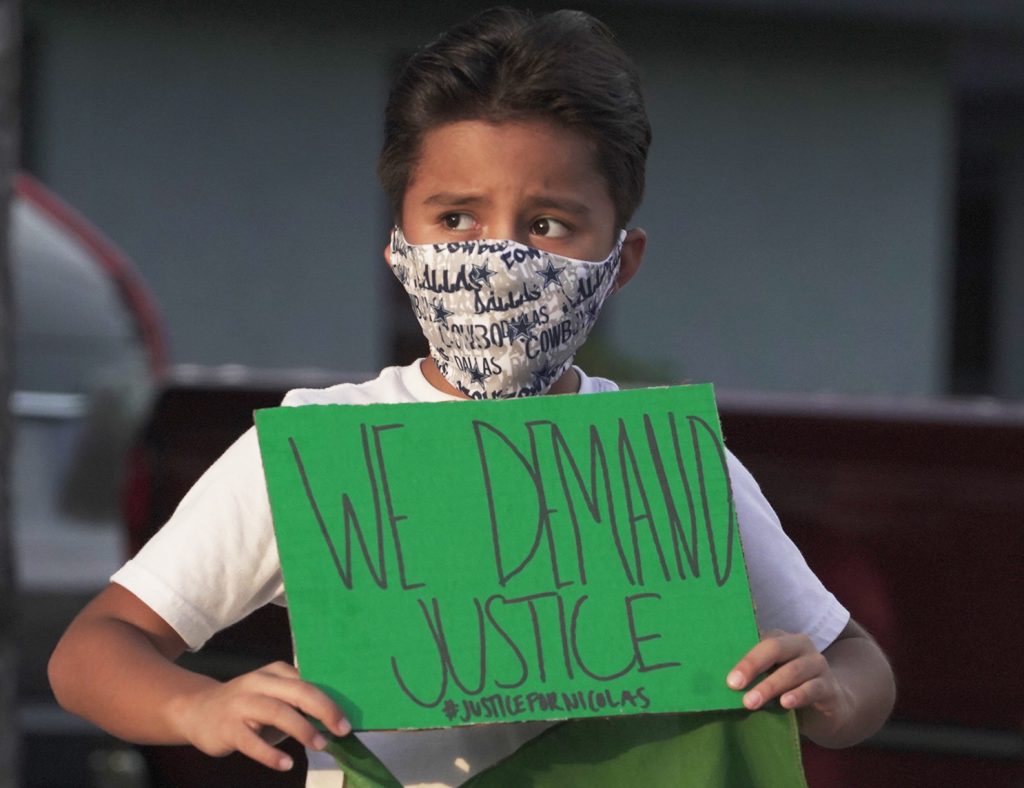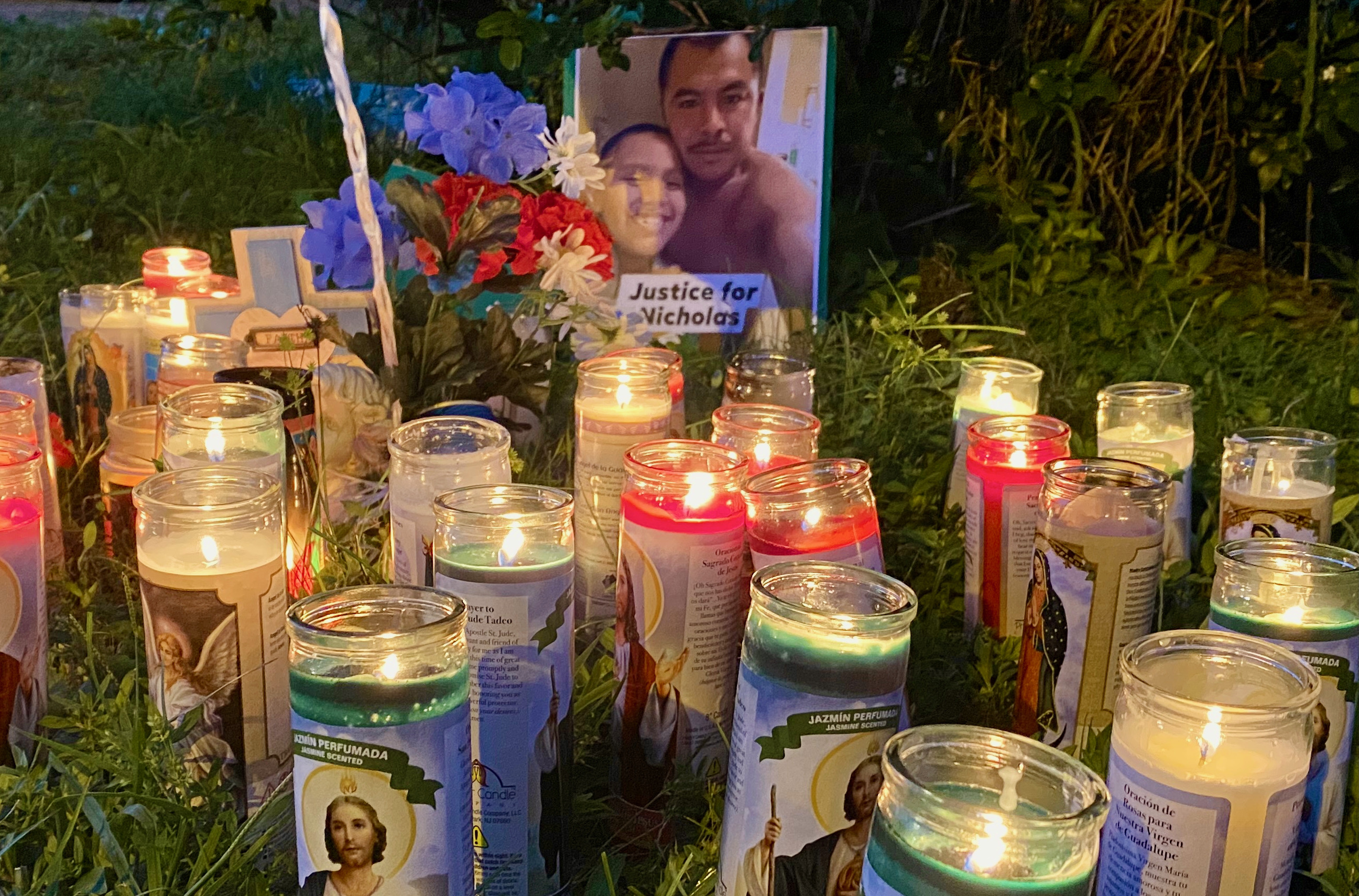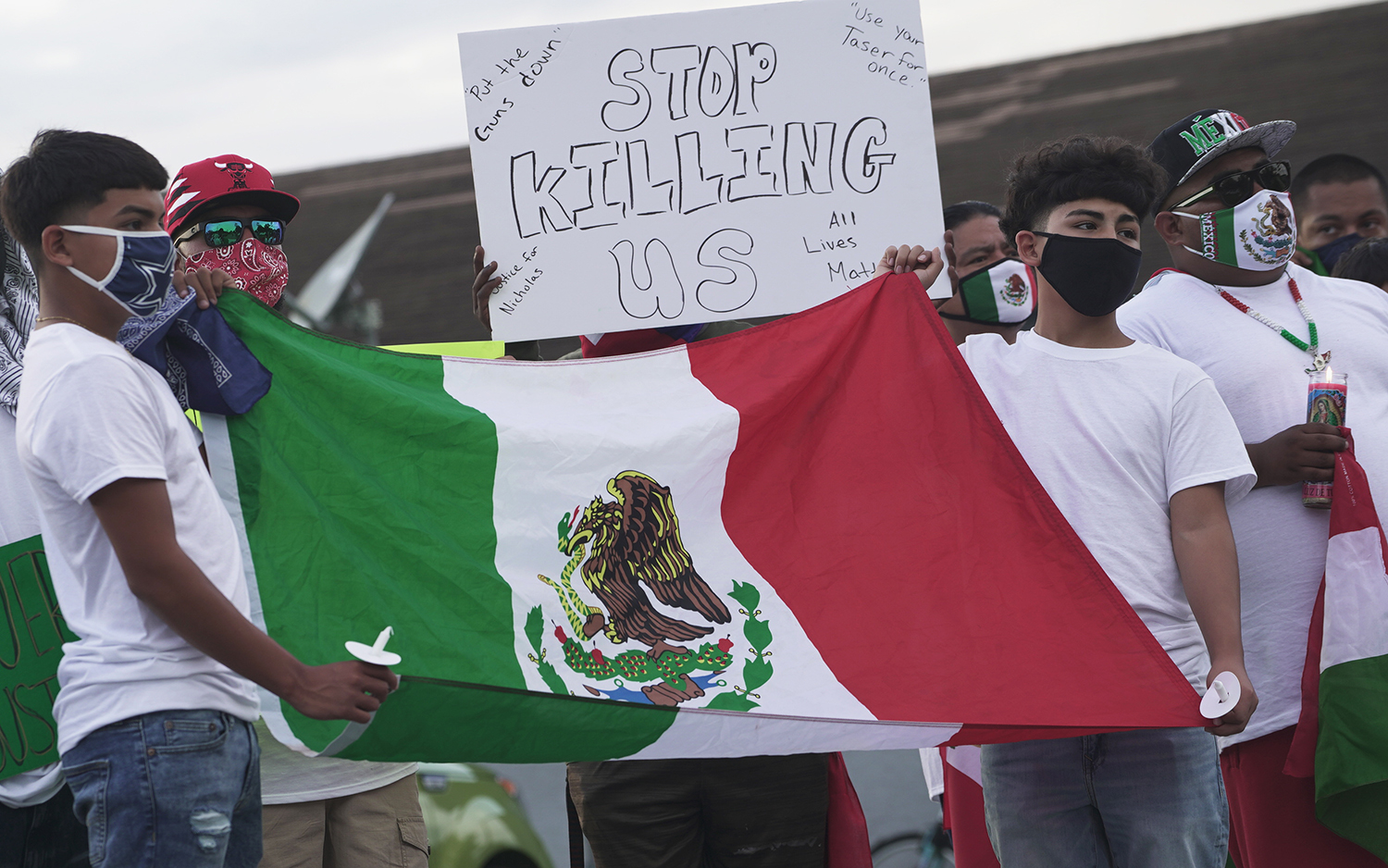
Collier County Sheriff’s Office issues conflicting statements on last month’s fatal shooting of Nicolas Morales;
Multiple discrepancies cast doubt on several key elements of the events leading up to Nicolas’ death at the hands of Collier County deputies;
Immokalee community demands answers, transparency, including release of Nicolas Morales’ autopsy report, any dashboard camera footage of the incident, transcript of any communications among the three deputies involved…
Shortly after 1:00 am on September 17th, on a quiet street in a housing development located just south of Immokalee called Farm Worker Village, Corporal Pierre Richard Jean of the Collier County Sheriff’s Office fired four gunshots from his service weapon at Nicolas Morales Besanilla, fatally wounding him. Nicolas was a farmworker, a single father of a 13-year-old son, and a longtime part of the CIW family. You can read our original post on his killing here.
Since Nicolas’ shooting, his family and the broader Immokalee community have called on the Collier County Sheriff’s Office (CCSO) to provide a complete and transparent accounting of the circumstances leading up to his death, including any audio or visual recordings of the encounter (unfortunately, as the shooting took place in the middle of the night, there is apparently no cell phone footage to provide a neutral bystander timeline of events). Instead, apart from releasing a recording of the 911 call that resulted in the deputies being dispatched to the scene, the CCSO has only issued three short statements on the shooting, each one adding critical— but conflicting— new details to the last.
Indeed, rather than build a believable picture, and comprehensive understanding, of the 13 seconds between the deputies’ arrival on the scene and the firing of the four fatal shots, the CCSO’s statements contain a number of significant inconsistencies, factual discrepancies that prompt yet more urgent questions. In the end, rather than assuage the community’s concerns, the three statements only cast more doubt on any conceivable justification for Nicolas’ violent and untimely death at the hands of those committed to protecting — not killing — the public whom they serve.
Here below are the CCSO’s three different statements on the shooting, a brief analysis of some of the key inconsistencies among them and the questions they prompt, followed by the community’s demands for the immediate release of the information necessary for Nicolas’ son, his family, and his community to have faith that justice will be served.
**********************
Collier County Sheriff’s Office Statements (3) on the Killing of Nicolas Morales:
1. September 17 at 6:39 AM
Collier County Sheriff’s Office
Deputy-Involved Shooting In Immokalee
Collier County Sheriff’s Office deputies were called to the area of Edenfield Way in Immokalee at 1:12 a.m. Thursday in reference to a disturbance. Deputies arrived on scene and encountered the subject, who was armed with a shovel. They ordered the subject to the ground, but he did not comply.
Details are still developing, but during the encounter the subject advanced toward the deputies. One of the deputies felt in fear for his safety and the safety of those around him and fired his weapon at the armed subject.
Deputies administered first aid and the subject was transported to NCH Northeast where he was pronounced deceased.
CCSO is conducting a criminal investigation into the shooting. An administrative investigation is also being conducted, per agency policy.In accordance with agency policy, the deputy who fired the weapon Thursday has been placed on administrative leave.
Details will be released as they become available.
2. September 17 at 12:07 PM
Collier County Sheriff’s Office
Deputy-Involved Shooting In Immokalee
UPDATE: The decedent has been identified as Nicholas Morales-Bessannia, 37, of Immokalee. The investigation has also revealed that in addition to being armed with a shovel, Morales-Bessannia produced a sharp-edge weapon as he charged toward deputies. We are releasing the 911 audio. The investigation is continuing.
3. September 22 at 11:15 PM
Collier County Sheriff’s Office
As we continue to investigate the Sept. 17 officer-involved shooting in Immokalee we can provide the following update:
Three deputies responded to the 1:12 a.m. call for help from a frightened woman on Edenfield Way reporting that a man she did not know was banging on her door demanding to be allowed inside. She advised the dispatcher that the man was armed with a shovel.
Cpl. Pierre Richard Jean, K9 Cpl. Nathan Kirk and Deputy Brian Tarazona responded to the scene. When they arrived they saw a man later identified as Nicholas Morales-Bessannia, 37, near the front door of the residence with a shovel in his left hand. Morales-Bessannia began walking down the driveway toward deputies still armed with the shovel. As he approached deputies he ignored repeated commands from the deputies in English and Spanish to get on the ground. When Morales-Bessannia was getting close to the deputies he released the shovel from his left hand and produced a shiny, sharp object in his right hand that deputies believed to be a deadly weapon. He then ran toward the deputies, continuing to ignore commands to get on the ground. When Morales-Bessannia was even closer to the deputies, still charging toward them with the weapon in his right hand raised in a manner that deputies perceived to be threatening, Cpl. Jean, in fear for his life and the lives of the other deputies, fired four gunshots and Cpl. Kirk released K9 Gomez. The dog bit Morales-Bessannia in the right shoulder. The entire encounter between deputies and Morales-Bessannia lasted 13 seconds. During the last few seconds of their encounter, Morales-Bessannia was running toward the deputies with a raised weapon.
Deputies rendered first aid until EMS arrived on scene.
The shiny object was later determined to be a pair of sharp landscaping shears. Landscaping tools and shovels are considered to be deadly-force weapons when used in the manner that Morales-Bessannia was utilizing them.
As is our policy, we are continuing to conduct both a criminal investigation and an administrative investigation. The entire criminal investigative file will be forwarded to the State Attorney’s Office for their independent review.
**********************
Inconsistencies in the CCSO statements:

Nicolas’ death — the death of one human being at the hands of three others, all three officers of the law professionally trained to protect the community — cries out for full transparency. Instead, the three statements, taken together, present a disturbingly unsettled narrative in which crucial details shift or are omitted, “weapons” emerge over time, and behavior dramatically morphs with each new statement. Rather than provide much-needed clarity into the events of that night, a common sense reading of the three statements only offers more confusion and multiple, key contradictions.
Two glaring inconsistencies call particular attention to themselves.
First, given its pivotal role in the events that led to Nicolas’ death, we can start with the “weapon” that, in Nicolas’ hand, allegedly caused Cpl. Jean to “fear for his life and the lives of the other deputies.” What, exactly, was the weapon in the first place? According to the first statement, Nicolas was “armed” with a shovel; the first statement made no mention of a separate, sharp object. But later that day, the CCSO posted a second statement, an update to the first, that claimed Nicolas had “a sharp-edge weapon” as he “charged toward [the] deputies.” The update still didn’t, however, identify exactly what kind of weapon it was. Five days later, the third CCSO version of events says Nicolas dropped the shovel and “produced a shiny sharp object” (later identified as “landscaping shears”) and threatened the deputies with it, and that this is why Cpl. Jean shot him.
Common sense tells us that a weapon so frightening, and potentially harmful under the circumstances that existed that night, as to justify the use of deadly force would have been present and clearly identified in the first report — not five days later.
Second, if the weapon is one factor in the equation justifying — or not justifying — Cpl. Jean’s actions, then certainly Nicolas’ alleged behavior toward the deputies must also figure in the analysis. And so, the description of Nicolas’ behavior should be equally as unequivocal as the nature of the weapon itself. Yet, while the CCSO’s first version of events said that Nicolas “advanced toward the deputies,” their update claims he “charged” toward them. The third statement provides a still different picture of events, saying Nicolas “began walking down the driveway,” then “ran toward” the deputies, and was “charging” toward them “with a raised weapon” (the “landscaping shears” so conspicuously absent from the first report) when he was shot.
Again, common sense tells us that, because Nicolas’ behavior that night was crucial to Cpl. Jean’s decision to fatally shoot him, an image of that behavior would have been burned into Cpl. Jean’s visual memory from the very first moment. Instead that image seemingly changed drastically over the course of five days.
These shifting versions of events call into question the CCSO’s commitment to transparency in addressing Nicolas’ death at the hands of the police. The first statement, for example, makes no mention whatsoever of the “weapon,” i.e. the garden shears, that the third statement identifies as the source of Cpl. Jean’s fear for his life. Meanwhile, the third statement makes it clear that the shovel, i.e. the other “weapon” identified in the first statement as responsible for that fear, was already on the ground when Cpl. Jean shot Nicolas. On the key questions around Nicolas’ death that demand answers, the three statements are, quite simply, deeply disturbing to any reader seeking the truth.
The lack of consistency — and the use of language that seems crafted to protect their own, rather than to help Nicolas’ family and the Immokalee community understand and heal — seriously undermine the public’s trust in the CCSO to handle this matter fairly, and add to the already immeasurable anguish of Nicolas’ family.
Questions and demands for answers:

Many questions remain about the actions of the Collier County deputies that night, including:
- Why did they kill a man who was alone and — by their own description — armed with a garden tool, when, 1) they outnumbered him three-to-one, and 2) they were armed with a trained police K9 in addition to their guns? How can the decision to take a human life in that set of circumstances possibly be justified, or square with police training?
- Why didn’t they simply use the K9 to subdue Nicolas if he was, as they described him, 1) armed only with a sharp object — there was no allegation that any of the deputies believed the object to be a firearm — and 2) at such a distance that he walked, then ran, for the better part of 13 seconds and still never reached the deputies? Isn’t that exactly the kind of non-lethal purpose K9s are trained to serve?
- Why was only one officer identified as fearing “for his life and the lives of his fellow deputies,” and not the others? And why did only one officer use deadly force against Nicolas, while another clearly felt the K9 was sufficient and the third officer drew no weapon at all? Was Cpl. Jean wrong in his estimate of the situation, or were the other two officers wrong?
- At what distance was Nicolas when Cpl. Jean killed him? And why wasn’t that distance mentioned in any of the reports when it would be an additional material factor in determining whether Cpl. Jean’s actions were justified?
- Why did Nicolas lose his life within 13 seconds of the deputies’ arrival, and what could have been done differently to save his life?
- Where did the very specific number of 13 seconds come from? If it is the product of a dash cam or other recording, where is that recording, and why hasn’t it been shared with the public?
The CCSO needs to restore public confidence, today, by releasing:
1) the results of Nicolas’ autopsy;
2) any dashboard camera footage of the incident, and;
3) any audio or text communications between the deputies and dispatch, or among the deputies themselves.
Nicolas Morales — a father, a brother, and a long-time Immokalee community member — died violently at the hands of police. The community needs to know that his death will be investigated fully and fairly, and that all actions necessary to ensure accountability and to prevent future tragedies will be taken. The release of this vital information will help to demonstrate the CCSO’s intention to act in good faith.
And in the wake of his violent death — and the failure of these three statements to cast much-needed light on the events surrounding it — Nicolas’ family, and the broader community of Immokalee, are in bad need of some good faith.


